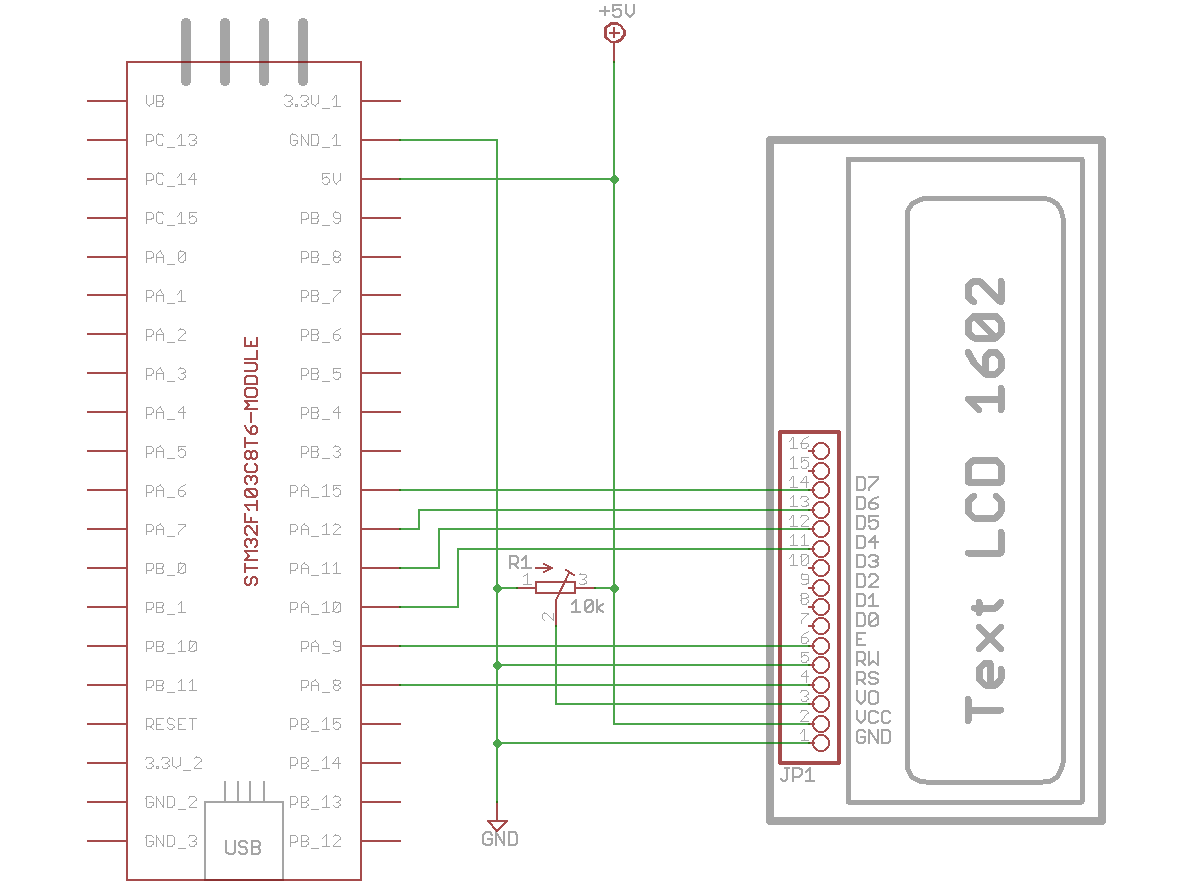Demo for STM32F103C8T6 with a Text LCD.
Text LCD driven by STM32F103C8T6 board
This is a fork of Wim Huiskamp's example program using his enhanced TextLCD library.
For more details see also Wim's wonderful notebook page TextLCD Enhanced.
Schematic

Wiring
| STM32F103C8T6 | Text LCD | |||
|---|---|---|---|---|
| GND | <=> | GND | ||
| +5V | <=> | VCC | ||
| +5V | <R1> | VO | ||
| PA_8 | <=> | RS | ||
| GND | <=> | RW | ||
| PA_9 | <=> | E | ||
| PA_10 | <=> | D4 | ||
| PA_11 | <=> | D5 | ||
| PA_12 | <=> | D6 | ||
| PA_15 | <=> | D7 |
Diff: main.cpp
- Revision:
- 0:271d74b09d64
- Child:
- 1:e10c603cf0ae
--- /dev/null Thu Jan 01 00:00:00 1970 +0000
+++ b/main.cpp Sun Jan 15 11:07:07 2017 +0000
@@ -0,0 +1,65 @@
+/* Hello World! for the TextLCD Enhanced Library*/
+
+#include "stm32f103c8t6.h"
+#include "mbed.h"
+#include "TextLCD.h"
+
+
+int main()
+{
+ confSysClock(); // configure system clock (72MHz HSE clock, 48MHz USB clock)
+
+ // Host PC Communication channels
+ Serial pc(PA_2, PA_3); // tx, rx
+
+ // LCD instantiation
+ TextLCD lcd(PA_8, PA_9, PA_10, PA_11, PA_12, PA_15, TextLCD::LCD16x2); // 4-bit bus: RS, E, D4, D5, D6, D7
+ Timer t;
+
+
+ pc.printf("TextLCD Enhanced Test. Columns=%d, Rows=%d\n\r", lcd.columns(), lcd.rows());
+
+ for (int row = 0; row < lcd.rows(); row++) {
+ int col = 0;
+
+ pc.printf("MemAddr(Col=%d, Row=%d)=0x%02X\n\r", col, row, lcd.getAddress(col, row));
+
+ lcd.putc('0' + row);
+
+ for (col=1; col < lcd.columns() - 1; col++) {
+ lcd.putc('*');
+ }
+
+ pc.printf("MemAddr(Col=%d, Row=%d)=0x%02X\n\r", col, row, lcd.getAddress(col, row));
+ lcd.putc('+');
+ }
+
+// Fill screen again and time it
+ t.start();
+
+ for (int row=0; row<lcd.rows(); row++) {
+ int col=0;
+
+ lcd.putc('0' + row);
+
+ for (col=1; col<lcd.columns()-1; col++) {
+ lcd.putc('*');
+ }
+
+ lcd.putc('+');
+ }
+ t.stop();
+ pc.printf("All my hard work took %f sec\r\n", t.read());
+
+// Show cursor as blinking character
+ lcd.setCursor(TextLCD::CurOff_BlkOn);
+
+// Set and show user defined characters. A maximum of 8 UDCs are supported by the HD44780.
+// They are defined by a 5x7 bitpattern.
+ lcd.setUDC(0, (char *) udc_0); // Show |>
+ lcd.putc(0);
+ lcd.setUDC(1, (char *) udc_1); // Show <|
+ lcd.putc(1);
+
+ pc.printf("Bye now\r\n");
+}